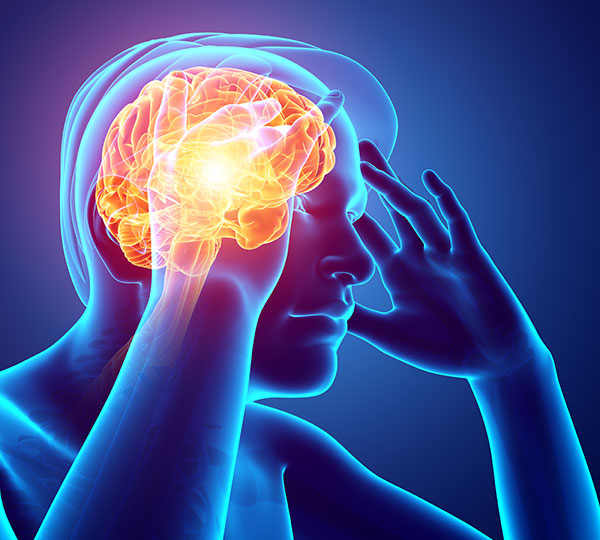Cranial Nerve Disorder
Neuropathic pain is pain that results from disease, injury or dysfunction of the central or peripheral nervous system. Neuropathic pain can be episodic or continuous. Individuals who experience neuropathic pain, may complain of a combination of spontaneous pain or pain provoked by touch.
Neuralgia
This condition is characterized by a sudden paroxysmal pain that radiates through the peripheral distribution of the nerve. This pain is episodic, and it usually has periods of remission between painful episodes. Neuralgia is named according to the nerve involved. The most common is Trigeminal Neuralgia. Other neuralgias include Glossopharyngeal and Nervus Intermedius (Geniculate) Neuralgia.
- Trigeminal Neuralgia:
This condition is also known as “Tic Doulourex.” It is a severely painful condition that affects one side of the face, along a distribution of one or more divisions of the Trigeminal Nerve. The pain is characterized by brief, electric, shock-like, lancinating pain that is typically precipitated by a non-painful stimuli, such as lightly touching the face, shaving, smoking, talking, and brushing the teeth. It may also occur spontaneously, without obvious stimulus.
- Pre-Trigeminal Neuralgia:
This condition is usually manifested with a dull, continuous aching toothache-like discomfort in the upper or lower jaw, which subsequently develops into Trigeminal Neuralgia. The diagnosis of Pre-Trigeminal Neuralgia is primarily based on the presence of dull toothache pain, because all neurologic findings, dental exams and imaging are normal.
Glossopharyngeal Neuralgia
This painful disorder is similar in character to Trigeminal Neuralgia, but is present in the distribution of the Glossopharyngeal Nerve, and may also be present in the distribution of the Auricular and Pharyngeal branches of the Vagus Nerve. The pain is severe, stabbing, burning and transient. The pain is located in the ear, the base of the tongue, tonsillar area or beneath the angle of the jaw. The pain is usually unilateral, even though some patients may experience bilateral pain. The episodes of pain usually last seconds to 2 minutes and are provoked by swallowing, chewing, talking, or yawning. It may remit and relapse like Trigeminal Neuralgia.
Nervus Intermedius Neuralgia
This is a rare condition that is characterized by unilateral episodes of severe pain felt in the throat, submandibular region or under the ear, with duration of minutes to hours. Pain is precipitated by swallowing, straining the voice, or head turning. A Trigger Zone is located on the lateral aspect of the throat.
Occipital Neuralgia
This condition is characterized by episodes of jabbing pain in the distribution of the Greater and/or Lessor Occipital Nerves, with occasional persistence of aching between attacks. The affected nerve is tender to palpation.
Numb Chin Syndrome
This condition is a neuropathy which is characterized by numbness, paresthesia, and occasionally dysesthesia in the Mental Nerve Dermatome. The cause of chin neuropathy can be related to dental procedures, such as injection of local anesthesia, dental implants, surgical endodontics. Other causes include pathologies such as dental infection or neoplasia (tumors) in close proximity to the nerve.
Post-Herpetic Neuralgia
Even though most people heal completely from an episode of Orofacial Herpes Zoster, some people experience irreversible damage to the skin (scarring) and sensory nerves. This pain is usually unilateral and develops in relationship to an acute herpes zoster infection that affected one or more branches of the Trigeminal Nerve. Post-Herpetic Neuralgia pain is described as an intense burning with intermittent stabbing.
Burning Mouth/Tongue Syndrome
This condition is characterized by constant burning pain without physical changes in the oral mucosa. This pain can last 4 to 6 months. There is no known cause for Burning Mouth Syndrome. It is a poorly understood condition and its most probably neuropathic in nature. Oral fungal infections such as Candidiasis (Thrush), can also cause burning pain of the tongue and oral mucosa, but physical changes of the mucosa and tongue, such as redness, inflammation and a removable white film, are always present.
Persistent Idiopathic Facial Pain (Atypical Facial Pain)
Atypical facial pain is characterized as continuous, daily pain limited to one side of the face. Pain may also spread to a larger area, is usually deep and poorly localized and often described as constant, pulling and aching. There are no abnormalities present of the jaws, face or nervous system.
Occlusal Dysesthesia/Phantom Bite/Occlusion
Patients with this condition complain of uncomfortable or incorrect bite, usually accompanied by emotional distress, when all dental and jaw findings are normal.
Atypical Odontalgia/Non-Odontalgic Toothache
This condition is also referred as “phantom tooth pain”. This is by definition a tooth or tooth area that aches with unknown cause. The pain is described as toothache that is dull, aching and persistent. The pain may increase or decrease in intensity, but rarely resolves. Most individuals who suffer from Atypical Odontalgia will have had multiple dental procedures performed in an attempt to remedy the pain. The patient is convinced that the pain is coming from the teeth. When dental treatment fails, the patient will often encourage the dentist to continue with additional therapy.
Complex Regional Pain Syndrome (CRPS)
CRPS is a condition characterized by onset of symptoms after a traumatic event.
Symptoms are not limited to the distribution of a peripheral nerve and are disproportionate to the injury. Edema/Swelling, decreased cutaneous blood flow, atrophy of the skin, hair and nails, autonomic changes in the region of pain, hyperalgesia (increased response to a stimulus that is normally painful) or allodynia (pain due to a stimulus that does not normally provoke pain) usually occurs in the course of the syndrome.

